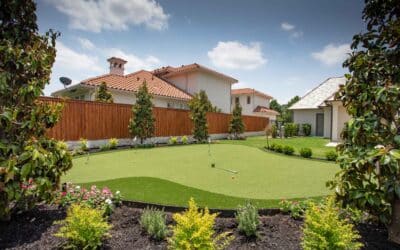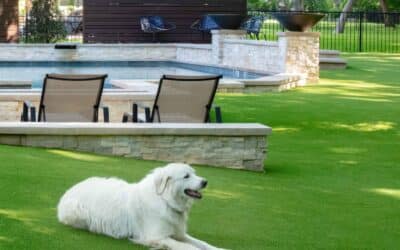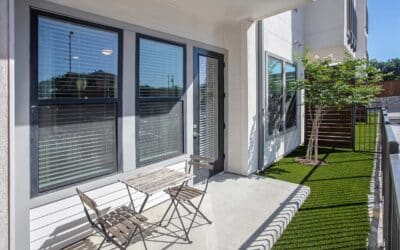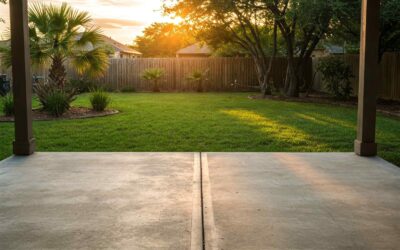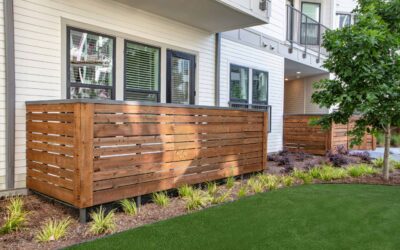When you opted for artificial grass, you may have thought that you’d waved goodbye to weeds on your lawn for good.
Isn’t artificial grass maintenance-free, after all?
Weeds are resilient if nothing else. They can sometimes take root on the surface or even penetrate through artificial grass backing from below and create a problem for homeowners. If that happens on your front lawn or backyard putting green, what should you do?
It’s best to deal with weeds promptly before they start to develop deeper root systems. Inspect your artificial grass from time to time. Contrary to popular belief, most weeds grow on the surface of artificial grass and so they are relatively easy to remove by hand or with some natural or commercial weedkiller — and raked away.
Let’s consider the weed problem in a little more detail and look at a few tips for how to treat and prevent weeds in artificial grass…
How can weeds grow through artificial grass in Texas?
Every gardener or lawn lover knows what a headache weeds can be. They are one of nature’s toughest entities — and even though installing artificial grass largely solves the “weed problem”, synthetic grass is not immune to weeds growing in it.
How? Why? Wasn’t your lawn installed with a weed barrier?
Even though professional installations take preventative measures against weeds growing, nature sometimes wins! Most homeowners assume that the weeds grow underneath the turf and penetrate the backing of the synthetic grass. That’s not necessarily the case.
Artificial turf generally has many layers, starving the weeds of the sunlight and water they need to grow from below and push through the backing. Professional installation teams like Artificial Grass Pros remove all weed growth from beneath the installation area and often fit weed barriers for good measure (more about this below).
Most artificial grass weed growth starts on the surface of the turf. Weeds spread their seeds very easily on the wind, through animal fur or even on fallen leaves. If your neighbor’s yard is overgrown with weeds or your yard is surrounded by trees or woodland, you’ll know how easily they spread.
Seeds can land on the surface of your lawn and take root in plant debris or the sand infill. Infill is the material between the blades of grass of your turf, used to give your fake grass a more natural look and feel.
Plain, white silica sand is one of the most popular infill materials. However, due to its heavy dust content and tendency to lock grains of sand together to create compacted spots, weeds and moss can take root there.
What types of weeds are common in Texas?
In Texas, we see a wide variety of common weeds that can make their way into your backyard, including:
- Dandelions
- Clover
- Thistles
- Henbit
- Crabgrass
- Nutsedge
- Chickweed
- Kentucky tall fescue
- Plantain
- Wood sorrel
- Spurge
- Knotweed
- Foxtail
- Quackgrass
How to treat weeds in artificial grass
Dealing with weeds on natural grass is well-documented but how do you handle this pesky problem when your grass is artificial? Fortunately, treating weeds on artificial grass is easier than with natural grass.
With real grass, weeds may develop deep root systems and grow out of control unless you know what you’re doing as a gardener. Sometimes, lawn specialists must be called in to combat a stubborn weed problem — adding to the overall cost of ownership of a natural grass lawn.
There’s none of that fuss or expense with an artificial grass lawn. Your area will stay looking fine and pristine year-round with minimal effort — and there’s very little chance of it becoming overgrown with weeds unless you move away for a year and nobody looks after your yard!
It’s best to inspect your lawn at least once every few weeks, removing debris and anything that shouldn’t be there. Follow these tips for treating weeds if they begin to find a home on your turf…
Tip 1: Simply remove by hand
The best way to treat weeds is simply to remove the weeds by hand, pulling them up root and all.
Look for weeds growing around the outer edges of your artificial grass. Grasp the weeds as close as possible to the base and pull them straight out of the ground. You should feel the roots losing their grip and remove them along with the visible part of the weed.
This is generally quite easy to do because most weeds grow from the infill and cannot penetrate deep into the soil like with natural grass. You may need to loosen the infill a little with a flathead screwdriver as you pull so that the top of the weed doesn’t break off and leave the roots embedded.
Tip 2: Apply a homemade weedkiller
Another simple, natural way to remove weeds from artificial turf is to create a vinegar-based mixture to spray on the weeds. You can mix white vinegar with a little dish detergent and salt for extra effect.
Use a standard spray bottle and spray the vinegar solution directly on the weeds. This nontoxic herbicide should tackle most weeds safely. If it needs another dose, repeat the process after a few days.
Even sprinkling normal table salt on weeds should help to kill them as it will deprive them of moisture. Make sure that the salt doesn’t get into other areas of your garden or dissolve in runoff that ends up in the flowerbeds as it won’t do your prize tulips any good!
Tip 3: Use a commercial weedkiller
Natural and non-natural herbicide sprays, granules and liquids feature heavily on the shelves of garden supply stores and home improvement outlets. Most commercial weed killers for artificial grass will work quickly on standard garden weeds if nothing else works.
Some weedkillers can selectively kill certain types of weeds while others remove almost anything that’s growing so be careful if you have prized flowerbeds, trees and shrubs on or around your artificial lawn.
Any strong weedkiller should be tested first on a small patch of grass before use on the entire lawn — and extra care should be taken with your choice of weedkiller if you install artificial dog turf.
Tip 4: Treat weeds more often if your yard is surrounded by vegetation
You’ll need to work a little harder to keep your artificial lawn weed-free if your property is surrounded by an area of long grass, woodland, forest or a nature reserve. In their natural environment, weeds spread especially easily by dispersing their seeds on the wind.
Check out our weed prevention tips below for further steps to protect your yard from unwanted growth.
How NOT to remove weeds from artificial grass
We do not recommend using any of the following methods to remove weeds from synthetic turf (or to clean it):
- Don’t pour boiling water on weeds
- Don’t use metal rakes/brushes on your lawn
- Avoid using pure bleach products
Weeds, pets and artificial lawns
Pet owners have an additional reason to be careful about weeds growing on their lawns…some weeds are toxic to pets.
Besides damaging the appearance of your lawn and potentially lowering its lifespan, weeds can trigger allergic reactions in humans and pets – or worse. It’s best just to remove anything that shouldn’t be on your artificial turf by hand or using natural substances.
How to prevent weeds in artificial grass
If you’ve recently used a commercial weedkiller to deal with a weed problem, there should be some residual effect, i.e., weeds will not grow back for a while. But we do know that they don’t give up so if seeds blow your way in the next “flowering season”, you could face the same problem again.
Prevention is better than a cure when it comes to weeds. That’s why a weed barrier may be a good idea for your artificial grass — but there are some homeowners for whom this will not be appropriate.
What is an artificial grass weed barrier?
What goes under an artificial lawn is just as important as what you see on the surface.
An artificial grass weed barrier is a fabric mesh that is placed directly beneath the turf area to keep weeds from growing through:
We need a graphic made to show the following type of cross section with weed barrier please, Chevie. This one is from here: http://www.rcartificialgrass.com/installing-artificial-grass Maybe no need to show the wire mesh and obviously change anything else that’s not appropriate for AGPros.
A good-quality weed barrier is one of many aspects that are often missed in DIY installations. Artificial turf should be installed professionally by an experienced team like Artificial Grass Pros — so that important details like weed barriers are not missed.
If you have pets, however, a weed barrier is not recommended. The mesh uses a cloth-like fabric that will trap and hold bacteria from pet urine, leading to unwanted odors. Dogs can pee on artificial grass but you’ll need to take a few extra measures to ensure your turf area remains healthy and free from smells.
Remember, a weed barrier is quite effective in preventing weeds from growing up from the soil but does not help with surface weeds growing from infill — which is how most weeds develop on artificial grass.
If you can’t install a weed barrier because of your dog, there are some other measures you can take to prevent weeds from growing,
Other ways to prevent weeds in artificial turf
The most important way to prevent weeds is to be vigilant and brush your artificial grass with a stiff brush from time to time. This is good practice for the general health and appearance of your artificial turf anyway.
Check for weeds regularly and pull them up as soon as you spot them. For extra protection, you can:
- Trim overhanging trees and hedges to reduce the chance of leaves accumulating and plant debris building up for weeds to take root in, especially in the hotter, humid months.
- Weed the flower beds and other vegetation on the perimeter of your artificial turf to avoid seeds blowing onto it.
- Use a leaf blower if you have one — this should remove weed seeds before they have a chance to take root.
- Spray your homemade weedkiller once every six months on patches of grass where you’ve had weeds before.
- Sprinkle a little cornmeal over suspect areas of grass where weeds have grown before to prevent germination of the seeds (cornmeal is nontoxic to nearby plants).
- Ensure proper drainage so that moisture does not accumulate and encourage weed growth and other problems.
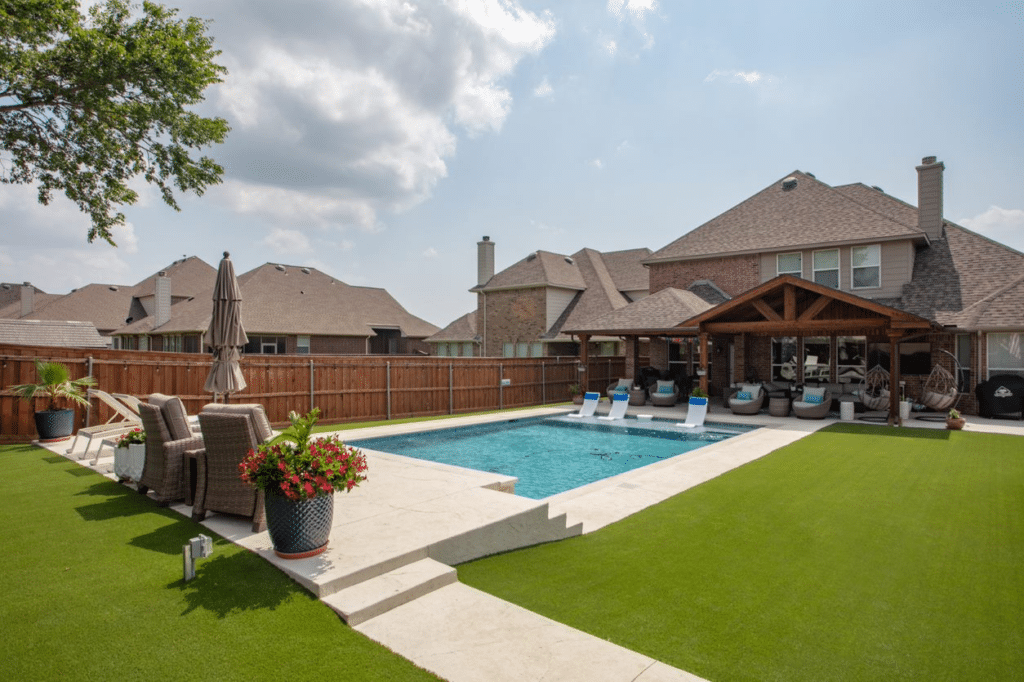
Note that many of the same tips for getting rid of flies and fleas on artificial grass also apply to preventing weeds.
Weed-free artificial turf installed in Austin, TX…
Artificial grass is not entirely maintenance-free and sometimes needs a helping hand to combat weeds — but it’s nothing compared to a real grass lawn.
Clearing weeds promptly from your artificial turf (by following the above tips) will keep your artificial grass area looking beautiful and lasting the distance.
At Artificial Grass Pros, all our synthetic turf is installed with weed protection and is designed for the precise conditions that homeowners face in the Austin area. We can look after your installation from start to finish. Reach out to us for a quote by calling 925.234.4349.

